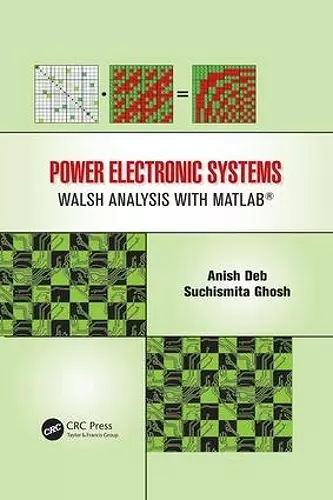Power Electronic Systems
Walsh Analysis with MATLAB®
Anish Deb author Suchismita Ghosh author
Format:Paperback
Publisher:Taylor & Francis Ltd
Published:30th Mar '17
Currently unavailable, and unfortunately no date known when it will be back
This paperback is available in another edition too:
- Hardback£205.00(9781482215960)

A Totally Different Outlook on Power Electronic System Analysis
Power Electronic Systems: Walsh Analysis with MATLAB®
builds a case for Walsh analysis as a powerful tool in the study of power electronic systems. It considers the application of Walsh functions in analyzing power electronic systems, and the advantages offered by Walsh domain analysis of power electronic systems.Solves Power Electronic Systems in an Unconventional Way
This book successfully integrates power electronics as well as systems and control. Incorporating a complete orthonormal function set very much unlike the sine–cosine functions, it introduces a blending between piecewise constant orthogonal functions and power electronic systems. It explores the background and evolution of power electronics, and discusses Walsh and related orthogonal basis functions. It develops the mathematical foundation of Walsh analysis, and first- and second-order system analyses by Walsh technique. It also describes the Walsh domain operational method and how it is applied to linear system analysis.
Introduces Theories Step by Step
While presenting the underlying principles of Walsh analysis, the authors incorporate many illustrative examples, and include a basic introduction to linear algebra and MATLAB® programs. They also examine different orthogonal piecewise constant basis functions like Haar, Walsh, slant, block pulse functions, and other related orthogonal functions along with their time scale evolution.
• Analyzes pulse–fed single input single output (SISO) first- and second-order systems
• Considers stepwise and continuously pulse width modulated chopper systems
• Describes a detailed analysis of controlled rectifier circuits
• Addresses inverter circuits
Power Electronic Systems: Walsh Analysis with MATLAB®
is written for postgraduate students, researchers, and academicians in the area of power electronics as well as systems and control."One of the salient features of power electronic dynamics is the switching of the waveforms involved in the phenomenon. However, time domain analysis of power electronics often uses Fourier series to represent waveforms despite its smooth nature and its difficulties to compactly represent switching signals. This book uses Walsh Series, a switching orthogonal set of functions, to more effectively represent waveforms in power electronics. The book may be the only one in the market with this philosophy."––J Jesus Rico-Melgoza, Universidad Michoacana de San Nicolas de Hidalgo, Morelia, Mexico
"… a remarkable job of presenting the subject in a clear and coherent manner. … My recommendation to anyone who is interested in the analysis any other system with such discontinuous phenomena: This book may guide you to the use of appropriate tools."—Ganti Prasada Rao, Member, UNESCO-EOLSS Joint Committee
"… an authoritative reference for researchers and engineering professionals with an interest in the area of power electronic systems, their optimization and practical applications."
—Radomir S. Stanković, Dept. of Computer science, Faculty of Electronic Engineering, Niš, Serbia
"… a refreshing approach based on Walsh analysis and presents an alternate approach to Fourier series approach that is usually followed. The material presented is quite systematic. Even if one does not have any prior knowledge on the topics, the book is still very much readable. It presents a detail bottom-to-top tutorial approach in each chapter, with adequate background material in first two chapters, which I am sure will make it quite easier for the students and practicing engineers to follow the concepts effortlessly."—Radhakant Padhi, Indian Institute of Science, Bangalore
ISBN: 9781138075023
Dimensions: unknown
Weight: 560g
298 pages